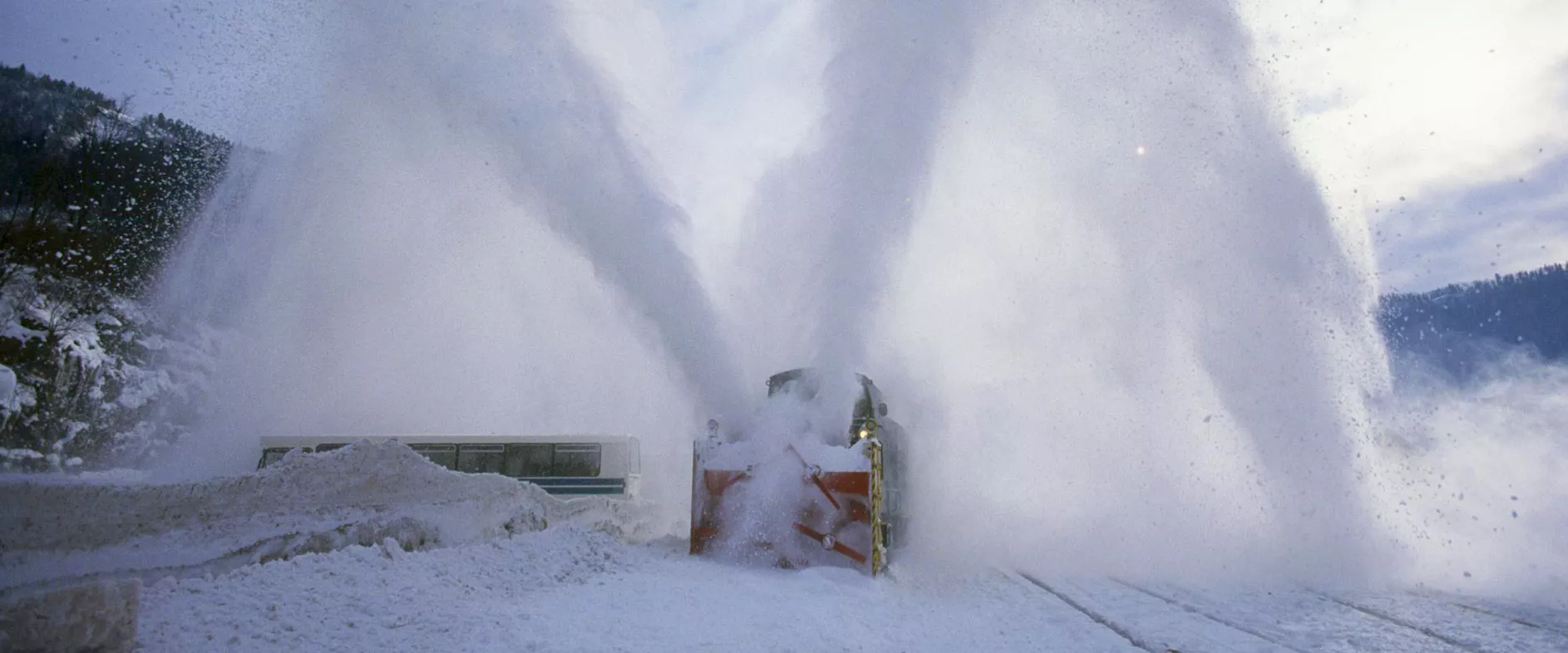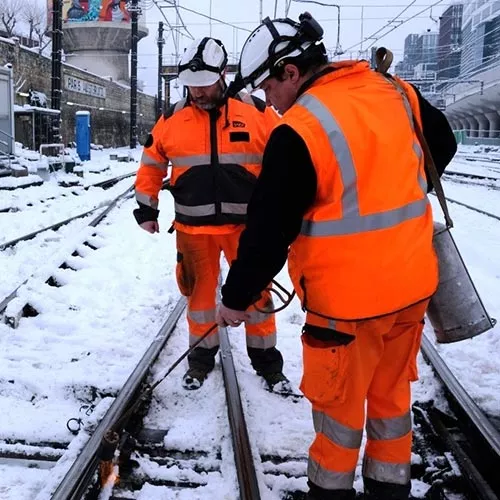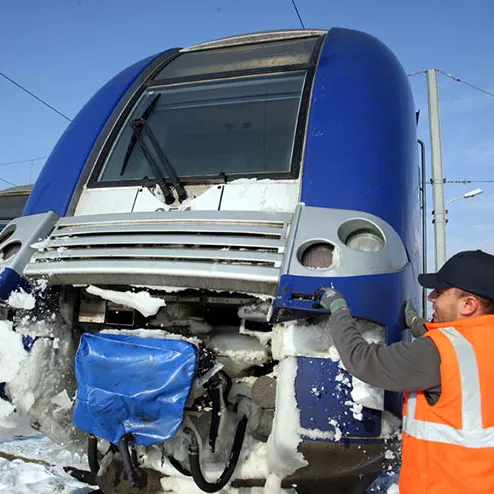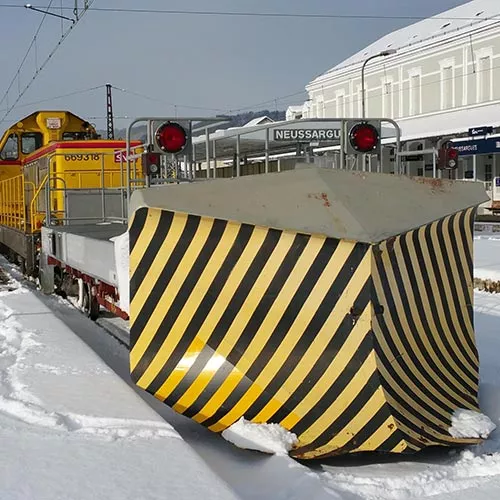
How we meet the challenges of extreme cold
Heavy snowfall and sub-zero temperatures have a major impact on the rail system and can cause delays or cancellations. That’s why we make preparedness a priority. It’s our way to minimize disruptions, keep you safe and make your journey as smooth as possible.
A problem familiar to operators everywhere
Autumn is one of the main seasons when adhesion becomes a problem. As leaves and rain fall onto the tracks, passing trains compact them into a thin, slippery layer that dramatically reduces grip—much like black ice on a road. It is a problem familiar to operators the world over.
Learn more about our winter preparedness plan

Preserving infrastructure
When snow falls, ice can build up, damaging infrastructure and delaying your train. Frost and ice on catenaries can bring some lines to a halt. Our action plan tackles this issue on multiple fronts to protect:
- switches and crossings: we use electric "switch heaters" to free these from ice, and arrange increased surveillance by the agents.
- catenaries: we de-frost overhead lines by using electric heating circuits. In addition, we have 20 “scrapers”—de-icing locomotives whose pantographs are fitted with steel bow bands—ready to run as soon as cold spells start.
Biodegradable anti-icing lubricant
We also prepare for ice by applying a special lubricant—95% biodegradable and hydrophobic—that limits the adhesion of water to contact wires and thus discourages frost formation. This also makes it easier for pantograph bows to remove frost as they pass over the contact wire, preserving them from wear and tear. A single application protects all trains, 24 hours a day, for 30 days.
43 snow ploughs
Our 43 snow-plough-equipped vehicles are serviced, tested and pre-positioned in high-risk areas so that they can intervene as quickly as possible should heavy snowfalls block the tracks. They include motorized vehicles and draisines fitted with snow-plough spurs capable of clearing snow from the network quickly if the snow depth is less than 30 centimetres.

43
snow ploughs

20
“scraper” locomotives

1
antifreeze lubricant, 95% biodegradable

Protecting rolling stock
As trains rush along the tracks, chunks of snow and ice can fly up, breaking windows or accumulating on critical rolling stock components. We prevent this by:
- installing protective covers or applying antifreeze around sensitive components like doors, suspension systems and the underside of carriages, to keep blocks of ice from forming
- repairing broken windows quickly
- reducing TGV speeds to 220 km/h or even 160 km/h, and slowing Intercités and TER trains to 120 km/h
- deploying rapid-response rolling stock teams around the country to jump in, fix broken windows and repair damaged equipment
- applying anti-icing fluid to the underside of TGV bodies at our Est Europeén Technicentre north-east of Paris to prevent snow from sticking.
The hazards of freezing rain—the other winter plague

Clearing snow from stations
Snow and ice can create slippery conditions and make access to station platforms dangerous. For our passengers’ safety and peace of mind, we start clearing and salting platforms as soon as snow flurries begin. For heavier snowfall, we also bring in several hundred rail workers to help clear tracks and keep trains operating smoothly, carrying our customers safely to their destinations.
Monitoring tracks
Steel contracts in cold weather, a phenomenon which generates cracks and may cause tracks to break. Track rails are thus controlled on a regular basis, either by special trains or by agents using portable ultrasound devices. They first place a transmitter-receiver on the track that sends waves inside the rail to its core. These waves are then reflected back to the source, or transducer. By calculating the time the ultrasound echo takes to make a “round trip”, teams can locate the internal flaw.
We also use our 43 snow plough vehicles, scraper trains and electric de-icing systems to maintain our tracks in good working order.

Keeping passengers informed
During the winter, heavy snowfall can cause SNCF to delay or even cancel certain trains. In all cases, we communicate this information to passengers through a range of vectors including "Info Trafic Neige" posters, "Perturbations neige” and "alerte Météo France" leaflets, e-mail/sms alerts, on-board announcements and more.
In exceptional situations, timetables of trains running are displayed in stations and alerts are sent by e-mail or text message. All changes to transport schedules and associated timetables are updated in real time on SNCF Connect.
Nearly 50 stations equipped to serve stranded travellers
In special situations, where it’s difficult to get suburban passengers to their homes within the Paris region or near major regional conurbations, we’ve equipped some 50 stations with large stocks of water, meals and blankets:
- 8 for the Intercités conventional network
- 15 for the TGV Atlantique high-speed line
- 4 for the TGV Est high-speed line
- 5 for the TGV Nord high-speed line
- 16 for the TGV Sud-Est high-speed line.
Teaming up with public emergency services
In the interests of passenger safety, we do not allow any trains to depart if a major weather risk is confirmed by our weather service provider. In the event of extremely disruptive situations, we have also signed assistance agreements with France’s prefectures; Protection Civile (a nationwide network of first responders); the Red Cross; and departmental fire and rescue services (SDIS).
Share the article